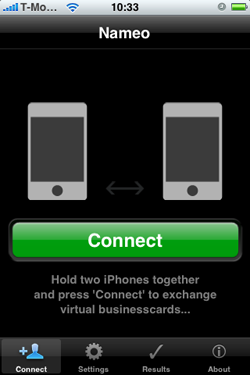
A few months ago iPhone application developer Tapulous announced FriendBook, an app that would allow users to hold shake their phones together to exchange contact information – a fun and simple alternative to pocketfuls of clumsy business cards. Unfortunately, FriendBook still remains unreleased after a wave of shakeups over at Tapulous, and while we’ve seen a few alternatives like rmbrME, none of them have the simplicity of a proximity-based, wireless transfer.
Thankfully developer Meganova BV has created an application called Nameo that manages to replicate much of the functionality promised by FriendBook. The app was released on the App Store last night and is available for $2.99 here.
To use Nameo, you open up the application on your iPhone and hit “Connect” as your peers do the same. The app will detect other phones in the vicinity and will display a list of available contacts. Clicking on a name will add that contact’s information to your iPhone’s address book. The process is very intuitive, though there was a noticeable lag time whenever I tried to add a contact.
In our testing the app seemed to work well, even when using a first generation iPhone that doesn’t have GPS. My main concern is that Nameo doesn’t seem to have any kind of authorization system when it comes time to swap contact information – the app just displays the name of everyone nearby who has hit Connect, and anyone standing in the vicinity is free to download their information. The app is also very barebones at this point, only allowing users to exchange their name, Email address, and phone number (the developer promises more options including contact photos in a future release).
Update: The phone does have a confirmation system – both users have to click Yes to allowing the other user to access their information. I misread the popup when we tested it.
Nameo is planning to introduce support for other platforms in the future, which will be essential if it ever hopes to become more than a neat trick – especially given the ubiquity of BlackBerrys in the business world. For now it’s a step in the right direction and hopefully will be enough to wake handset manufactures up to the fact that this is something people want, and that we’re desperately in need of a standard that works across all phones.